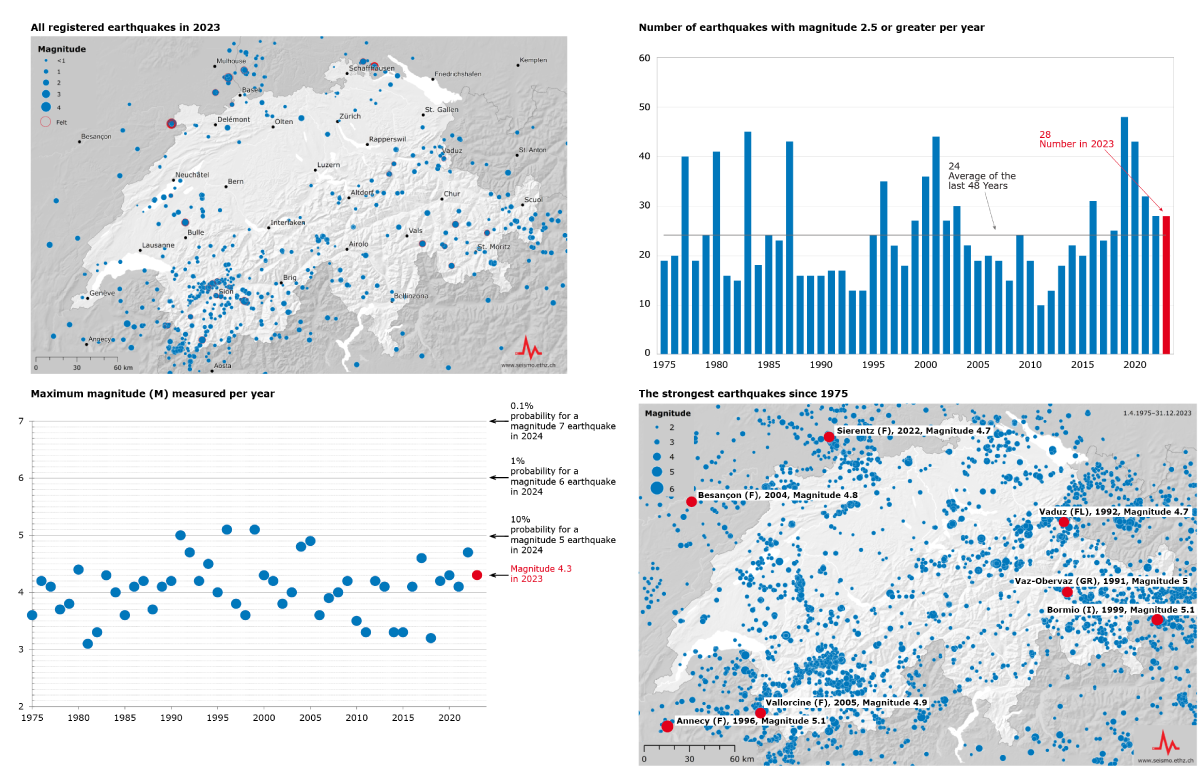2024-02-07
Earthquakes in Switzerland in 2023
The Swiss Seismological Service (SED) at ETH Zurich recorded around 1,500 earthquakes in Switzerland and neighbouring regions last year. This is the second highest number after 2019. Most of the quakes recorded in 2023 (Animation) were associated with earthquake sequences close to the Swiss border, near Singen (Germany), Sierentz (France) and Courmayeur (Italy). Last year's strongest earthquake, with a magnitude of 4.3, was also part of a sequence. This occurred in Haute-Ajoie near Réclère (canton of Jura). There were other locally felt earthquakes near Rossens (canton of Fribourg), Tiefencastel (canton of Grisons), Vaduz (Liechtenstein) and Mollis (canton of Glarus).
Read more...The past year was marked seismically by several earthquake sequences in which numerous localised earthquakes occurred over several days or even months. Such sequences accounted for the three strongest quakes of 2023. The most powerful was a 4.3-magnitude earthquake in Haute-Ajoie near Réclère (canton of Jura) on 22 March. This was also the strongest earthquake recorded in the region in the last 100 years. The tremors from the quake were clearly felt in the Jura and throughout the western Swiss Plateau. There were also isolated reports from Lausanne, Bern, Lucerne and Zurich. The second largest quake of 2023, with a magnitude of 3.8, also occurred as part of this sequence (on 29 May). Previously, this region was hit by a 4.1-magnitude earthquake at Christmas 2021, followed by several aftershocks.
The third largest earthquake last year took place outside Switzerland, near Sierentz in Alsace (France), and was felt widely as far as the Basel region and western Aargau. The earthquake had a magnitude of 3.6 and was related to the magnitude-4.7 quake that occurred there in September 2022. These quakes are located in the seismically active Upper Rhine Graben, which extends from the Vosges to the Black Forest. A sequence in the Hegau-Bodensee Graben (also known as the Hegau-Lake Constance Graben) near Singen (Germany) caused further smaller but still noticeable earthquakes in Switzerland. A total of ten quakes of magnitude 2.5 or above have occurred there since June 2023. The strongest earthquakes in this sequence so far took place on 27 June (magnitude 3.1), 29 June (magnitude 3.2) and 25 August (magnitude 3.4). All three were felt sporadically in Switzerland, particularly in the Schaffhausen region.
Several earthquakes felt locally despite small magnitude
Most of the approximately 1,500 earthquakes recorded were too weak to be felt by the population. Twenty-eight had a magnitude of 2.5 or greater, the same number as in 2022 and slightly more than the long-term average. Above this magnitude, earthquakes are usually felt close to the epicentre, as was the case with the quakes in March near Tiefencastel (magnitude 2.6) and Rossens (magnitudes 2.7 and 3.0).
Last year also saw a few earthquakes that could be clearly felt despite their smaller magnitude. This is usually due to a combination of shallow depth, local subsurface amplification effects and other topographic influences, as well as the timing of the earthquake. On the morning of 31 May, shortly before 6 a.m., over 50 people near Vaduz (Liechtenstein) felt slight tremors caused by a magnitude-1.8 earthquake. The quake on 14 December, which happened shortly after midnight near Mollis (canton of Glarus), was even smaller at magnitude 1.6. Because its hypocentre was very close to the surface, just a few hundred metres down, it was powerful enough to wake several people in Mollis and Näfels.
Earthquake impacts in Switzerland systematically determined for the first time
Although several thousand people notice earthquake tremors every year, major damaging earthquakes in Switzerland are becoming a distant memory. However, the earthquake risk model of Switzerland, published for the first time in 2023, shows that the impact of earthquakes on buildings and the associated financial and human losses can be very high. Urban areas in particular are at high risk from earthquakes due to their population density and number of buildings. The SED developed the earthquake risk model at the request of the Federal Council, together with the Federal Office for the Environment (FOEN), the Federal Office for Civil Protection (FOCP), EPFL and other partners from industry. It provides a valuable tool enabling the public, authorities and businesses to prepare for earthquakes and to better cope with the next damaging quake.
